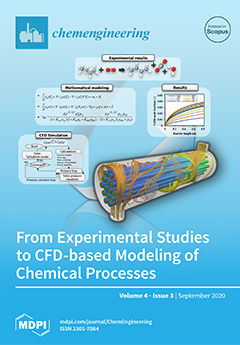It was demonstrated that the daily monitoring of electrical conductivity (EC) of scrubbing water can easily be used to determine the performance of biotrickling filters treating ammonia (NH
3) emissions, generated by livestock facilities. Two different measurement campaigns were carried out on
[...] Read more.
It was demonstrated that the daily monitoring of electrical conductivity (EC) of scrubbing water can easily be used to determine the performance of biotrickling filters treating ammonia (NH
3) emissions, generated by livestock facilities. Two different measurement campaigns were carried out on a pilot-scale biotrickling filter installed at a pig facility. Different phases of the operation were observed for each campaign, in accordance with EC values. For EC ranges of between 5 and 40 mS cm
−1, performance was similar for both campaigns, indicating that the nitrogen accumulated in water (
φ) was controlled by the operating conditions and biotrickling filter design (
φ = 205 g
N day
−1 corresponding to 1.71 mS cm
−1 day
−1). Due to the correlation established in Part A of this study, the performance of the biotrickling filter can be directly expressed as g
N h
−1 m
−3packing material without gas-phase monitoring. Thus, for an Empty Bed Residence Time of 1 s, the nitrogen accumulation capacity of the biotrickling filter was 24 g
N h
−1 m
−3packing material. For higher EC values, the ammonia mass transfer slowed down and stopped with EC at around 50–60 mS cm
−1 (campaign #1) and 70 mS cm
−1 (campaign #2). It was evidenced that the mass transfer stopped due to ammonia mass transfer limitation controlled by the driving force, although biomass inhibition can occur at these levels of nitrogen concentration in the scrubbing liquid. EC monitoring can also be used to assess the ratio of nitrogen accumulated in water
φ and amount of ammonia entering the system
φmax. Thus
φ/
φmax ratios of 41% and 27% were recorded for campaign #1 and #2 respectively.
Full article





